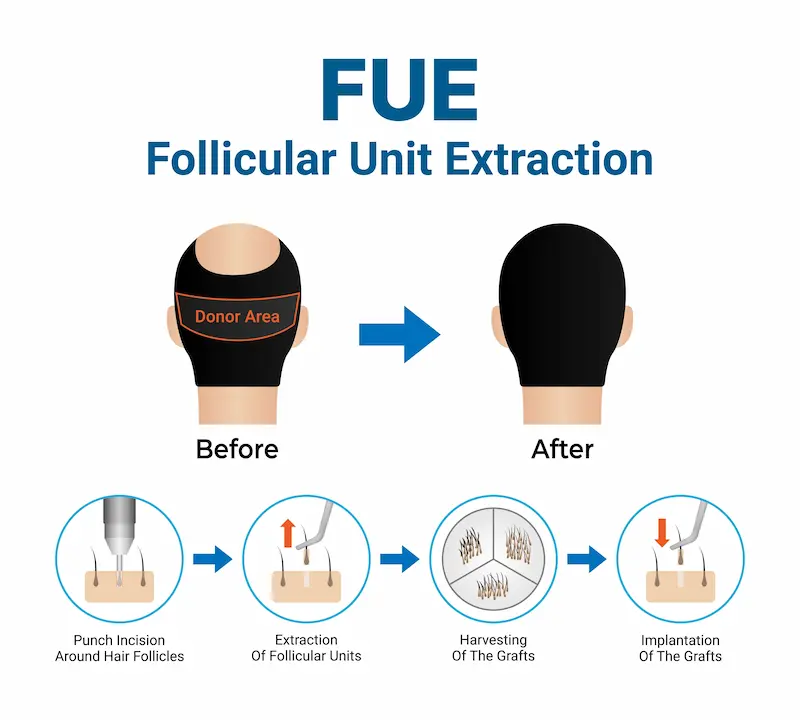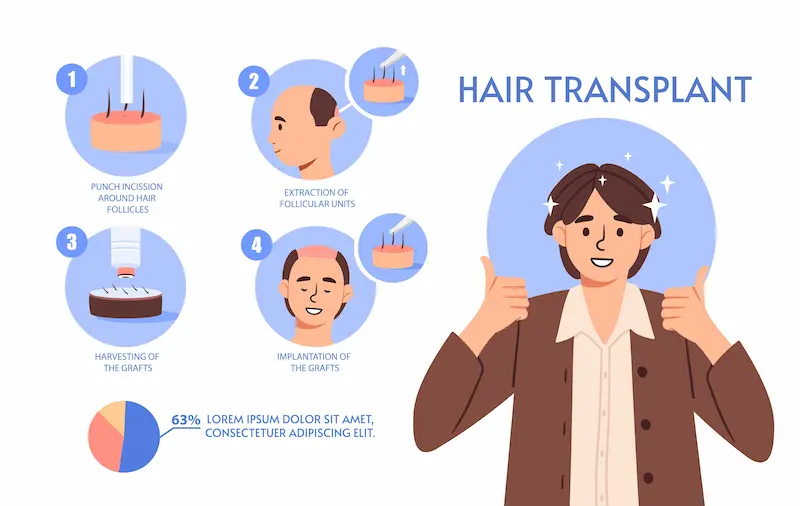Overview
Micro-motor FUE has transformed hair restoration, offering precision, faster recovery, and natural-looking results. Turkey leads the world in perfecting this technique, making it a global destination for effective and affordable hair transplants.
Table of Contents
Understanding the Micro-Motor FUE Technique
The Micro-motor FUE technique represents a significant advancement in hair restoration methods, combining automation with delicate precision to enhance effectiveness and patient comfort.
What Is the Micro FUE Technique?
The Micro FUE technique is an advanced version of Follicular Unit Extraction (FUE), which involves harvesting individual hair grafts from the donor area using specialized micro-sized punches. Unlike older methods, Micro FUE minimizes scalp trauma, significantly improves graft survival rates, and offers enhanced aesthetic outcomes.
How a Motorised FUE Punch Works
A motorised FUE punch is an electronically powered device designed to rapidly and precisely harvest hair follicles. It utilizes a rotating, hollow micro-punch to extract follicular units gently, significantly reducing procedure duration and donor-area damage compared to manual punches. This motorised precision ensures more viable grafts and superior aesthetic results.
Micro-Motor FUE vs Manual FUE: Key Differences
- Speed and Efficiency:
Micro-motor FUE significantly speeds up graft extraction, allowing higher numbers of follicles per session compared to manual FUE. - Precision and Consistency:
Motorised systems provide uniform depth and angle control, reducing human error common in manual extraction. - Reduced Fatigue:
Motorised tools lessen surgeon fatigue, further enhancing the procedure’s accuracy and consistency. - Patient Comfort:
Faster extraction times translate to shorter procedures and reduced discomfort for the patient.
FUE Hair Transplant Basics

FUE (Follicular Unit Extraction) hair transplant has revolutionized hair restoration with its minimally invasive approach and natural outcomes. Understanding the evolution and key benefits of FUE compared to traditional methods is crucial when choosing the right technique.
Evolution of FUE Hair Transplant Methods
FUE hair transplant has come a long way from its early days, evolving through continuous innovations:
- Manual FUE: Initially, surgeons relied solely on manual punches, offering precision but requiring extensive procedure times.
- Motorised FUE: Introduction of micro-motors significantly improved graft extraction speed, precision, and overall consistency.
- Robotic FUE: Leveraging artificial intelligence, robotic systems further enhance accuracy but involve higher costs and reduced surgeon control.
Today, Micro-motor FUE represents the optimal balance between precision, efficiency, and affordability.
Key Advantages Over FUT
When comparing FUE vs FUT, FUE provides distinct benefits:
- No Linear Scarring: Unlike FUT’s noticeable strip scar, FUE leaves minimal dot-like scars, offering greater flexibility in hairstyles.
- Reduced Healing Time: Recovery after FUE is significantly quicker and less painful compared to FUT.
- Less Invasive: FUE is minimally invasive, minimizing trauma, bleeding, and infection risks.
These advantages have made FUE, particularly Micro-motor FUE, a preferred choice among patients worldwide.
Benefits of Choosing Micro-Motor FUE
Choosing Micro-motor FUE provides distinct advantages, including higher graft survival, quicker procedures, minimal discomfort, and excellent aesthetic results. These key benefits have propelled the popularity of the method among international patients.
High Graft Survival & Natural Density
Micro-motor FUE ensures higher graft survival rates due to its precise, gentle extraction process. The motorised device maintains the follicle’s integrity, preventing damage and ensuring a dense, natural-looking outcome. Patients typically experience robust and consistent hair growth post-transplant, achieving aesthetically satisfying results.
Faster Sessions With Motor Assistance
Compared to manual methods, motorised FUE dramatically reduces procedure times. With Micro-motor assistance, surgeons can extract significantly more grafts in shorter sessions, benefiting both the surgical team and the patient by decreasing fatigue, discomfort, and overall treatment duration.
Minimal Scarring & Quick Recovery
Micro-motor FUE creates tiny, precise extraction sites, significantly reducing scalp trauma. As a result:
- Patients experience minimal bleeding, swelling, or discomfort.
- The recovery period is shorter, allowing most patients to return to daily routines within a few days.
- Scarring is minimal and almost invisible, providing patients freedom in hairstyle choice post-procedure.
Step-by-Step Micro-Motor FUE Procedure
Understanding the Micro-motor FUE procedure helps prospective patients prepare confidently for treatment. Below are the essential steps involved, from initial planning to implantation, highlighting choices and methods tailored to individual needs.
Pre-Operative Assessment & Planning
The journey begins with a detailed consultation and assessment. Key elements include:
- Scalp and Hair Analysis: Determines donor hair density, scalp condition, and recipient site evaluation.
- Hairline Design: Personalized according to the patient’s facial structure and aesthetic preferences.
- Graft Calculation: Determines the number of grafts required to achieve desired density.
A detailed surgical plan ensures personalized, successful outcomes.
Graft Extraction With the Micro Motor
During extraction, surgeons use the motorised punch to gently isolate and remove individual hair follicles:
- The device precisely penetrates around follicular units.
- Follicles are carefully extracted without causing damage to surrounding tissues.
- Extracted grafts are immediately preserved in a specialized solution, ensuring their viability for transplantation.
Implantation Options: FUE vs DHI
After extraction, implantation can proceed using different methods, primarily:
- Standard FUE Implantation: Recipient sites are created manually; grafts are placed into incisions. This is efficient for extensive coverage.
- DHI (Direct Hair Implantation): Utilizes a specialized Choi pen to simultaneously create sites and implant follicles, ideal for precise hairline restoration and density improvements.
The choice between FUE and DHI implantation depends on individual hair restoration goals, desired density, and budget considerations.
Micro-Motor FUE vs Other Techniques
Selecting the right hair transplant technique involves understanding the comparative advantages and scenarios suited to each method. Here we clarify how Micro-motor FUE compares to FUT, manual FUE, robotic FUE, and DHI, aiding informed decision-making.
Micro-Motor FUE vs FUT (Strip Surgery)
Micro-motor FUE differs significantly from FUT (Follicular Unit Transplantation):
- Scarring: FUT leaves a visible linear scar at the donor area, limiting hairstyle options. Micro-motor FUE has virtually invisible dot-like scars.
- Recovery Time: Micro-motor FUE offers rapid healing within days, compared to weeks needed with FUT.
- Comfort: FUE is minimally invasive, significantly reducing post-operative pain compared to FUT.
Motorised FUE vs Robotic FUE vs Manual FUE
Each FUE technique has unique characteristics:
- Manual FUE: Precise but slower, more physically demanding, and prone to human error.
- Motorised FUE: Offers optimal balance between precision, efficiency, and affordability.
- Robotic FUE: Highly precise due to AI integration but substantially more expensive and lacks surgeon’s intuitive adjustments.
Motorised FUE generally emerges as the preferred solution, combining cost-effectiveness, accuracy, and surgeon control.
When to Choose DHI Instead of Micro-Motor FUE
While Micro-motor FUE suits most scenarios, DHI (Direct Hair Implantation) may be better when:
- Precision & Density: Targeting smaller, specialized areas such as the frontal hairline.
- Immediate Implantation: Reducing graft handling time, improving follicle survival.
- Higher Budgets: Patients willing to invest in premium techniques for focused areas.
Ideal Candidates for Micro-Motor FUE Hair Transplant
Candidates best suited for Micro-motor FUE include those:
- Experiencing male or female pattern baldness.
- With sufficient donor hair at the back or sides of the head.
- Seeking minimal downtime, discreet scarring, and rapid recovery.
- Looking for natural and aesthetically pleasing results.
Recovery Timeline & After-Care for Micro-Motor FUE
Understanding post-procedure care enhances comfort and results:
Immediate Post-Op Care
- Keep your head elevated to minimize swelling.
- Follow prescribed medications and gentle scalp cleaning protocols.
- Avoid strenuous activities and direct sunlight exposure initially.
Week-by-Week Healing Milestones
- Week 1: Mild redness and scabbing; gentle washing begins.
- Week 2-4: Scabs fall off, mild shedding occurs, new hair follicles begin resting phase.
- Month 2-4: Early growth begins, gradually increasing density.
- Month 6-12: Significant visible growth, fuller density, and natural appearance established.
Cost of Micro-Motor FUE Hair Transplant in Turkey
Turkey provides affordable yet high-quality Micro-motor FUE:
Factors Affecting Price
- Number of grafts required.
- Surgeon’s expertise and clinic reputation.
- Inclusion of services like accommodation, transportation, and medications.
Comparing Packages Across Clinics
Carefully evaluate packages, considering graft number, surgeon’s credentials, clinic standards, and overall patient reviews, ensuring best value for investment.
FAQs
No, the precision of motorised punches typically results in less trauma, quicker healing, and higher graft survival rates compared to manual methods.
Typically, 2,500 to 4,500 grafts can comfortably be transplanted in a single Micro-motor FUE session, depending on individual donor density and needs.
Micro-motor FUE success rates exceed 90%. Long-term maintenance involves basic hair care routines and sometimes supplementary treatments like PRP or medications to enhance hair health and longevity.


